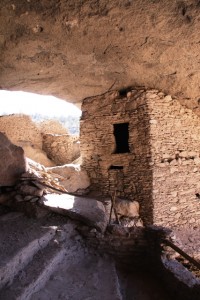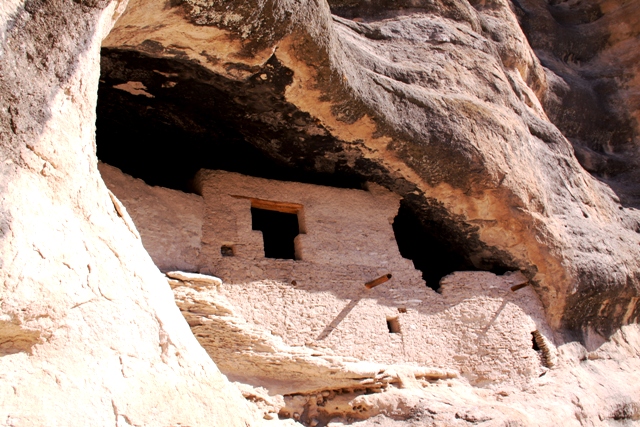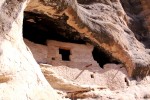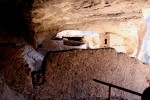Gila Cliff Dwellings-New Mexico: Occupied at a time when living was easy…
Poised on the edge of the Gila Wilderness stand 700-year-old homes build into the sides of the cliffs that overlook this portion of southwestern New Mexico—the original condominiums, if you will. Once belonging to the Mogollon people of the Southwest United States, the Gila Cliff Dwellings are situated amidst the Mogollon Mountains and surrounded by the Gila National Forest.
Inhabited from around 1275 to 1300, the cliffs that make up the Gila Cliff Dwellings were formed by volcanic activity. Based on intensive study, archaeologists have discerned that in the five cliffs that constitute the Gila Cliff Dwellings, there were likely somewhere around 46 rooms. It is suggested that about 10 to 15 families lived in the Dwellings during the roughly 25-year period of habitation.
Though the Mogollon peoples’ stay in the cliffs was notably short, there is no discernible motive for their ultimate departure. However, their reasons for choosing the area to reside in are clear: “It’s right near the headwaters of the Gila River,” said Gila Cliff Dwellings National Monument tour guide Garrett McAllister, “so you have three different forks of the Gila coming together.” Beyond that, the mesa above the cliffs and the Gila River provided ideal farmland, and the Mogollon peoples were able to hunt wildlife and gather berries. Further, as added protection, the thickly wooded wildlife area provided shelter for the families living in the cliffs.
Initial European contact with the site of the Cliff Dwellings didn’t even come until 1878, over 500 years after the dwellings had been

abandoned. After being explored by a New Mexico emigrant, knowledge of the site became widespread and the Cliff Dwellings became a national monument. In the early 1900s, several mummified bodies were found around the Dwellings, further spurring interest in the site. Private collectors, however, took most of the bodies, and only one is housed in the Smithsonian Museum. This mummified body was discovered in 1912, when a burial ground was discovered and with it a mummified infant later named Zeke.
A site quite off the beaten path, the Dwellings are about 40 miles from their closest city, Silver City, New Mexico. Though not terribly far in terms of mileage, the trip from Silver City to this designated national monument is two hours each way, making it a four-hour trip, not including the ample amounts of awe-inspired gawking while at the cliffs.
The Cliff Dwellings are located in a designated wilderness area (in fact, the Gila Wilderness is the nation’s first wilderness area), which means that no obvious signs of human presence, including the intrusion of roads, are allowed on the landscape.

Consequently, according to McAllister, the majority of structures that make up the cliff dwellings are exactly as they were when the Mogollon people built them in the 1270s. “About 80 percent of the structures here are original,” he said. Only at certain spots have recent reconstructions been erected, and the difference between the original structures and small spots of improvement is easily discernible to the attentive tourist. “If you look carefully enough, you can see what’s been reconstructed, so you can appreciate the difference,” said McAllister.
In addition to tours of the area, there is a museum near the Dwellings, located in the visitor center, that contains a number artifacts found at the site, as well as a plethora of information about the history and culture of the Dwellings and the Mogollon peoples.
Between the expansive Gila Wilderness and the Aldo Leopold Wilderness, which together with the Blue Range Wilderness make up the Gila National Forest, there are more than a thousand miles of hiking and endless other outdoor activities to make the Gila Cliff Dwellings National Park an enormous tourist draw. The slopes of the Mogollon Mountains provide ideal trails for enthusiastic hikers, as does the Gila River Canyon.
Five popular day hikes, though, are the most common for visitors to take part in, and each begins near the Cliff Dwellings or the Gila

Visitor Center. Each hike covers different terrain, and there is a trail to suit hikers of every experience level who wish to see the expansive landscape of the Gila Wilderness. The shortest hike available is just under two miles and has very little elevation, while the longest is about eleven miles and reaches an elevation of 1,300 feet. A guided tour of the Gila Cliff Dwelling area is another option for visitors less inclined to hike on the more advanced trails: the daily “Trail to the Past” tours include a short, quarter mile hike to one of the smaller Dwellings.
Three campgrounds open all year round are also popular destinations within Gila National Forest. Two of the campgrounds, Forks and Grapevine, provide a distinctly primitive camping experience. With water only available from the Gila River, campers must be prepared to filter or chemically treat any water they use. Further, no tables or grills are provided. For visitors wishing for a slightly less rustic approach to camping, the two Scorpion campgrounds provide treated water, along with tables and grills. All three sites have vault toilets available and are free of charge, offered on a first come, first serve basis.

Another popular hot spot for visitors are the nearby hot springs. There are several in the wilderness area, the most easily accessible being Lightfeather, a 20 minute walk from the Gila Cliff Dwellings National Park visitor center. The most popular hot spring, Jordan, typically appeals to the more eager hikers visiting the park, as it is a six to eight mile hike from the visitor center.
Outside of the Cliff Dwellings, a number of alternative activities are available to visitors in the Gila National Forest and the other two wildernesses of the area. Whitewater Canyon and Little Bear Canyon are both nearby and offer breathtaking views of the surrounding areas as well as extensive hiking opportunities. Similarly, Lake Roberts, though an artificial body of water, provides a popular day trip for park visitors.
In planning a visit to the Gila Cliff Dwellings National Monument or the surrounding areas, tourists have the option of staying in Silver City or Deming for the duration of their visit. Both cities have a variety of lodging to choose from, and the distance to the Dwellings is roughly the same from both cities.
Weather in the park is very moderate, so park employees insist that any time of the year is ideal for visiting. The mild climate brings a

rainy period between July and August, and moderately cool to cold nights during spring, fall and winter.
The Gila Cliff Dwellings National Park has special extended hours during the summer months. From Memorial Weekend to Labor Day, the main Cliff Dwellings trail is open from 8:30 a.m. to 5 p.m., and the visitor center is open from 8 a.m. to 5 p.m. The rest of the year, the trail is open from 9 a.m. to 4 p.m. and the visitor center is open from 8 a.m. to 4:30 p.m.
By Kimberlee Frederick
Photos: Rick Shandley









